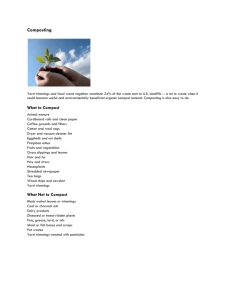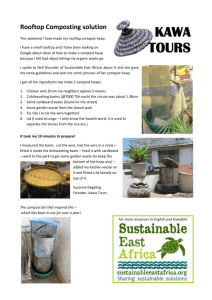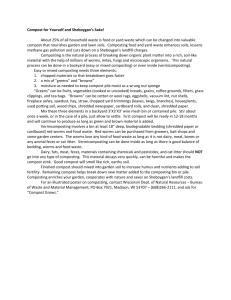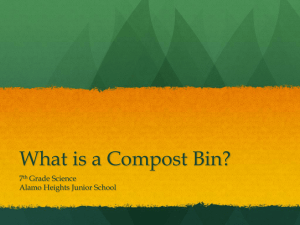What Is a Compost Pile?
advertisement
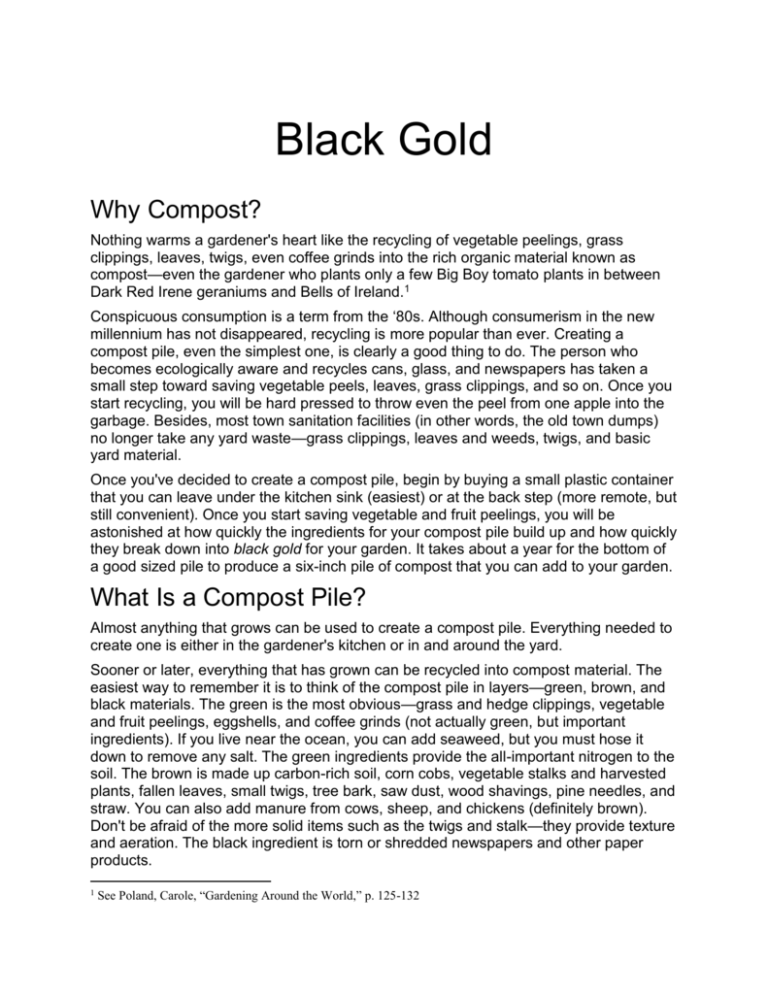
Black Gold Why Compost? Nothing warms a gardener's heart like the recycling of vegetable peelings, grass clippings, leaves, twigs, even coffee grinds into the rich organic material known as compost—even the gardener who plants only a few Big Boy tomato plants in between Dark Red Irene geraniums and Bells of Ireland.1 Conspicuous consumption is a term from the ‘80s. Although consumerism in the new millennium has not disappeared, recycling is more popular than ever. Creating a compost pile, even the simplest one, is clearly a good thing to do. The person who becomes ecologically aware and recycles cans, glass, and newspapers has taken a small step toward saving vegetable peels, leaves, grass clippings, and so on. Once you start recycling, you will be hard pressed to throw even the peel from one apple into the garbage. Besides, most town sanitation facilities (in other words, the old town dumps) no longer take any yard waste—grass clippings, leaves and weeds, twigs, and basic yard material. Once you've decided to create a compost pile, begin by buying a small plastic container that you can leave under the kitchen sink (easiest) or at the back step (more remote, but still convenient). Once you start saving vegetable and fruit peelings, you will be astonished at how quickly the ingredients for your compost pile build up and how quickly they break down into black gold for your garden. It takes about a year for the bottom of a good sized pile to produce a six-inch pile of compost that you can add to your garden. What Is a Compost Pile? Almost anything that grows can be used to create a compost pile. Everything needed to create one is either in the gardener's kitchen or in and around the yard. Sooner or later, everything that has grown can be recycled into compost material. The easiest way to remember it is to think of the compost pile in layers—green, brown, and black materials. The green is the most obvious—grass and hedge clippings, vegetable and fruit peelings, eggshells, and coffee grinds (not actually green, but important ingredients). If you live near the ocean, you can add seaweed, but you must hose it down to remove any salt. The green ingredients provide the all-important nitrogen to the soil. The brown is made up carbon-rich soil, corn cobs, vegetable stalks and harvested plants, fallen leaves, small twigs, tree bark, saw dust, wood shavings, pine needles, and straw. You can also add manure from cows, sheep, and chickens (definitely brown). Don't be afraid of the more solid items such as the twigs and stalk—they provide texture and aeration. The black ingredient is torn or shredded newspapers and other paper products. 1 See Poland, Carole, “Gardening Around the World,” p. 125-132 The objective is to create a medium in which microbes, fungi, and insects can grow and feed. Millions of microorganisms attack the compost materials and turn them into crumbly, sweet-smelling dirt, which enhances the full flowering of flower and vegetable gardens. The gardener's real helpers are microbes. Microbes are efficient little machines that surpass roots in getting nitrogen, phosphorus, and water to the plants. In keeping with the tight balance of the compost, the plants provide the microbes with sugar. These microbes stay close to the roots, protecting their own food supply by warding off root-rot fungi and parasites that can topple the most graceful delphiniums.2 The symbiotic relationship that the gardener has with all the living things in the kitchen and yard that make up the compost is parallel to the roots of the vegetables, flowers, shrubs, and trees in the yard. How Do You Make a Compost Pile? Creating a compost pile can go from the very simple to the more complex. You can create a simple two-hole system that the colonists brought from England. Or you can create a two-part, side-by-side one that will serve not only you but all the homeowners into the next millennium. You can also create a dig-as-you-go system, which means digging holes along side your vegetable and flower plants. First, dig a hole, and fill it with today's vegetables and fruit peels and coffee grinds. Then dig a second hole right beside the first hole, and throw the soil on top of the first hole. The next day, fill the second hole with peelings, maybe a few pages from the newspaper, and dig another hole next to it. You can create this hole-by-hole system in all your flower and vegetable beds, beside shrubs and along flowered walkways. Of course, one way to have a compost pile is to buy prefabricated units made of plastic, wood, wire, or metal. They are available at garden centers or from catalogs. These small units can be used on balconies or rooftops, patios or porches, beside front steps or back yards. The next step up is, of course, to simply choose a site at the back of the yard or behind a tool shed or the garage. You can also plant a few small shrubs or comfrey plants in front if you are meticulous about having a clutter-free yard. Make a small pile that you can dig out from behind, so as the material becomes "ripe," you can shovel it out and add it to your garden. You can control the pile by using garbage bags with the bottoms cut out and vents on the side for ventilation. Simply tip it over slightly, and dig out from the bottom. If you take the time to create this small compost pile, you can easily escalate it to the next level. A mid-range compost pile is made up of six wooden stakes approximately five feet long and enough chicken wire to cover the outside perimeter and down the middle. (Decide on the size before you go to the local hardware store and buy a pitchfork for turning the mixture.) Place the stakes into the ground-three in the back and three in the front. Tack chicken wire around three sides and one in the middle to separate the old from the new. You can dress the structure up by adding two swinging gates. Dig up the grass at the bottom of the bin to improve drainage and to ease the way for the beneficial insects that will be feasting on your compost pile. 2 See Sutton, Brad “Microbiology in Everyday Life,” p. 75-98 Start by adding the green, brown, and black layers. If you have a variety of materials, you should start with branches, twigs, hedge clippings and any of the thicker materials, all of which will provide ventilation. Then add the green layer-grass and soft-bodied plants. To the top add some shredded newspapers, soil and/or ground limestone. Moisten the mixture, but be careful to not over-water. You need enough moisture to facilitate the decaying process, but not too much to cut off ventilation, which can create a bad odor. In all cases, the smaller the materials, the better, especially when you are just beginning the compost pile. You can let the combination sit for a while, or begin turning it over with a pitchfork. The Taj Mahal of compost bins is one made from cinder blocks. Again, you need to find a convenient place—behind the garage or in the back corner of the yard, and you can camouflage the site by planting shrubs and/or comfrey plants. Even better, you can put potted plants on the edge, turning it into a showcase for your contributions to saving the earth by recycling. This pièce-de-resistance is made from two kinds of cinder blocks— standard with holes and solid. The bin is made up of two 4' bins separated by a row of cinder blocks on top of a three-inch cement foundation. The standard size of a cinder block is 15½ x 7½ x 7½ inches. A good sized compost pile can be made with 17 finishing half-size cinder blocks called sofers and approximately 40 cinder blocks. You can arrange the blocks in a variety of ways. What’s the Cost? The costs vary, depending on whether or not you use a professional construction worker, but figure on $500. The compost's best friend, next to the microorganisms that are its lifeline, is comfrey (symphytum caucasicum). It's mainly used as a medicine; its leaves can be used in a tea or eaten. But for the gardener, comfrey is a catalyst that heats up the green, brown, and black layers and accelerates the decaying process. Comfrey can be planted in front of or around the compost, providing a lovely green shield with soft pink and lavender flowers. The next best thing about comfrey is it resiliency. Once planted, the roots are there to stay. Break off the leaves down to the base of the stalk, throw them into your compost to fire it up, and within weeks new shoots will appear. The leaves and stalks have a slippery juice that makes the breaking off a bit more arduous than would appear. It's easier to simply cut the leaves and stalks with clippings shears. In any case, placing a few comfrey plants around your compost pile will enhance your compost and your garden. Hot or Cold? Small compost piles are usually "cold"; that is, the material never really heats up enough to kill weed seeds and other items that you do not want to recycle into your garden. A "hot" compost is better. Since decomposition starts at about 68° and stops at 140°, anything that percolates near those temperatures is wonderful. A "hot" compost that stays between 130 and 160 degrees for three to five days will kill off any diseased items that you may have inadvertently added to the soil and the weed seeds that can terrorize a garden. Of course, the hotter the compost pile, the more quickly the decaying process, and the faster turnaround you will receive from your clippings, peelings, and weeding. The trade-off is "hot" compost piles need to be kept moist and turned often. They crave the "green" and "brown" ingredients. The vents in the plastic bags or containers help with ventilation and water and snow run-off, but the vents also cool down the mix. Compost and Soil Most soil is either sandy or clay. Adding compost to the soil enhances the quality of the soil, making it rich with black gold. COMPOSTING DO’s and DON'Ts DO keep your compost pile at least three feet square. DO keep it moist, especially in warm weather. DO keep a healthy mix of green, brown and black ingredients. DO cut up vegetables rinds, such as cantaloupes, watermelons, and corncobs, into smaller segments. DO add lobster and clam shells. DO turn over the compost to aerate and mix the ingredients. DO cover with a chicken wire mesh to keep moist and keep out animals. DON'T add any cooked or raw meats, bones, or fat. DON'T add weeds unless you have a "hot" compost. DON'T add diseased plants or ones that have been treated with chemical pesticides. DON'T add pressure-treated lumber or plywood.


